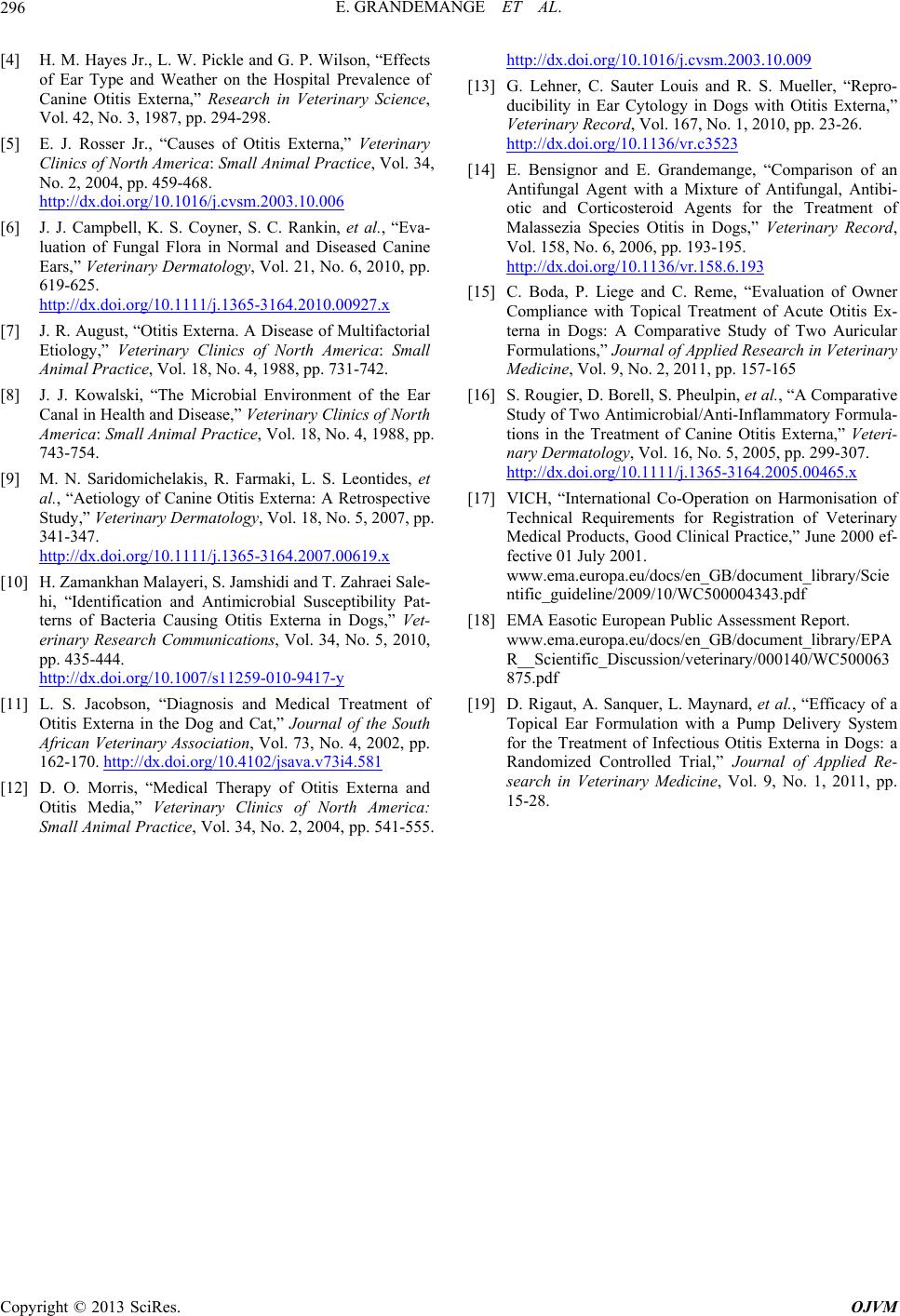
E. GRANDEMANGE ET AL.
296
[4] H. M. Hayes Jr., L. W. Pickle and G. P. Wilson, “Effects
of Ear Type and Weather on the Hospital Prevalence of
Canine Otitis Externa,” Research in Veterinary Science,
Vol. 42, No. 3, 1987, pp. 294-298.
[5] E. J. Rosser Jr., “Causes of Otitis Externa,” Veterinary
Clinics of North America: Small Animal Practice, Vol. 34,
No. 2, 2004, pp. 459-468.
http://dx.doi.org/10.1016/j.cvsm.2003.10.006
[6] J. J. Campbell, K. S. Coyner, S. C. Rankin, et al., “Eva-
luation of Fungal Flora in Normal and Diseased Canine
Ears,” Veterinary Dermatology, Vol. 21, No. 6, 2010, pp.
619-625.
http://dx.doi.org/10.1111/j.1365-3164.2010.00927.x
[7] J. R. August, “Otitis Externa. A Disease of Multifactorial
Etiology,” Veterinary Clinics of North America: Small
Animal Practi c e, Vol. 18, No. 4, 1988, pp. 731-742.
[8] J. J. Kowalski, “The Microbial Environment of the Ear
Canal in Health and Disease,” Veterinary Clinics of North
America: Small Animal Practice, Vol. 18, No. 4, 1988, pp.
743-754.
[9] M. N. Saridomichelakis, R. Farmaki, L. S. Leontides, et
al., “Aetiology of Canine Otitis Externa: A Retrospective
Study,” Veterinary Dermatology, Vol. 18, No. 5, 2007, pp.
341-347.
http://dx.doi.org/10.1111/j.1365-3164.2007.00619.x
[10] H. Zamankhan Malayeri, S. Jamshidi and T. Zahraei Sale-
hi, “Identification and Antimicrobial Susceptibility Pat-
terns of Bacteria Causing Otitis Externa in Dogs,” Vet-
erinary Research Communications, Vol. 34, No. 5, 2010,
pp. 435-444.
http://dx.doi.org/10.1007/s11259-010-9417-y
[11] L. S. Jacobson, “Diagnosis and Medical Treatment of
Otitis Externa in the Dog and Cat,” Journal of the South
African Veterinary Association , Vol. 73, No. 4, 2002, pp.
162-170. http://dx.doi.org/10.4102/jsava.v73i4.581
[12] D. O. Morris, “Medical Therapy of Otitis Externa and
Otitis Media,” Veterinary Clinics of North America:
Small Animal Practice, Vol. 34, No. 2, 2004, pp. 541-555.
http://dx.doi.org/10.1016/j.cvsm.2003.10.009
[13] G. Lehner, C. Sauter Louis and R. S. Mueller, “Repro-
ducibility in Ear Cytology in Dogs with Otitis Externa,”
Veterinary Record, Vol. 167, No. 1, 2010, pp. 23-26.
http://dx.doi.org/10.1136/vr.c3523
[14] E. Bensignor and E. Grandemange, “Comparison of an
Antifungal Agent with a Mixture of Antifungal, Antibi-
otic and Corticosteroid Agents for the Treatment of
Malassezia Species Otitis in Dogs,” Veterinary Record,
Vol. 158, No. 6, 2006, pp. 193-195.
http://dx.doi.org/10.1136/vr.158.6.193
[15] C. Boda, P. Liege and C. Reme, “Evaluation of Owner
Compliance with Topical Treatment of Acute Otitis Ex-
terna in Dogs: A Comparative Study of Two Auricular
Formulations,” Journal of Applied Research in Veterinary
Medicine, Vol. 9, No. 2, 2011, pp. 157-165
[16] S. Rougier, D. Borell, S. Pheulpin, et al., “A Comparative
Study of Two Antimicrobial/Anti-Inflammatory Formula-
tions in the Treatment of Canine Otitis Externa,” Veteri-
nary Dermatology, Vol. 16, No. 5, 2005, pp. 299-307.
http://dx.doi.org/10.1111/j.1365-3164.2005.00465.x
[17] VICH, “International Co-Operation on Harmonisation of
Technical Requirements for Registration of Veterinary
Medical Products, Good Clinical Practice,” June 2000 ef-
fective 01 July 2001.
www.ema.europa.eu/docs/en_GB/document_library/Scie
ntific_guideline/2009/10/WC500004343.pdf
[18] EMA Easotic European Public Assessment Report.
www.ema.europa.eu/docs/en_GB/document_library/EPA
R__Scientific_Discussion/veterinary/000140/WC500063
875.pdf
[19] D. Rigaut, A. Sanquer, L. Maynard, et al., “Efficacy of a
Topical Ear Formulation with a Pump Delivery System
for the Treatment of Infectious Otitis Externa in Dogs: a
Randomized Controlled Trial,” Journal of Applied Re-
search in Veterinary Medicine, Vol. 9, No. 1, 2011, pp.
15-28.
Copyright © 2013 SciRes. OJVM